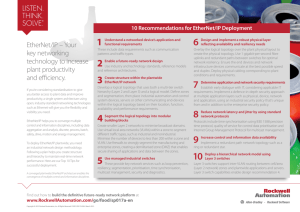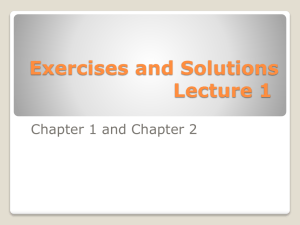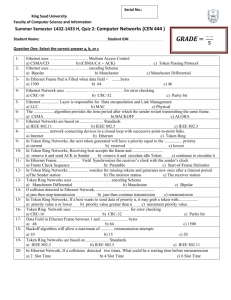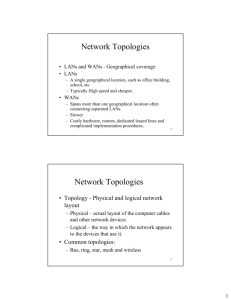LAN Topologies, Access Methods
advertisement
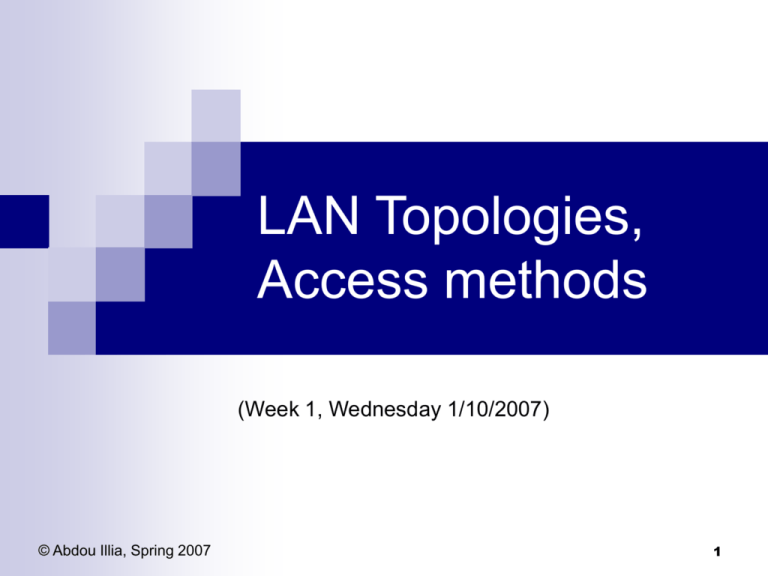
LAN Topologies, Access methods (Week 1, Wednesday 1/10/2007) © Abdou Illia, Spring 2007 1 Learning Objectives Describe LAN topologies Describe major LAN access methods (Ethernet, Token ring, and FDDI) 2 Network Topologies Physical topology is different than Logical topology Physical topology = Shape of the network How Logical topology How actually messages are transmitted in the LAN Three main topologies Bus computers connect to each other in the network Ring Star Topologies differ in terms of: Cost (both to install and maintain) Performance and Reliability 3 Bus Topology Patch cable Built by connecting nodes (PCs or Servers) to a Bus using patch cable Terminators signal the physical end to the segment 10Base2 & 10Base5 Ethernet are the most prevalent bus networks. 4 Advantages of Bus Topology Works well for small networks Relatively inexpensive to implement Disadvantage of Bus Topology Potential for congestion with network traffic 5 Ring Topology Logical network arrangement Nodes (workstations and servers) attached at points around the ring Data goes around the ring from node to node Implemented using a MAU (Multistation Access Unit) 6 Advantages of Ring Topology Well-suited for transmitting signals over long distances on a LAN Enables reliable communication 7 Disadvantages of Ring Topology Expensive Not used as widely as bus topology Fewer equipment options Fewer options for expansion to high-speed communication 8 Star Topology Most common physical network design Multiple nodes attached to a central wiring point 9 Advantages of Star Topology Low startup costs Offers opportunities for expansion Most popular topology in use; wide variety of equipment available 10 Disadvantages of Star Topology Single point of failure (Hub, etc.) Requires more cable than Bus topology 11 LAN Access Methods Access Method = Set of rules governing how computers access the network Ethernet IEEE Token ring IEEE 802.3 specifications 802.5 specifications FDDI (Fiber Distributed Data Interface) ANSI Most Common Access methods used in LAN X3T9.5 (High-speed variation of token ring) IEEE = Institute of Electrical and Electronic Engineers 12 Ethernet Many Ethernet (IEEE 802.3) standards Uses CSMA/CD access method for data transmission on a network CSMA/CD* : 1) 2) 3) 4) All computers (“carriers”) listen (“sense”) for traffic on the LAN If no traffic, computer that wishes to transmit may transmit If collision occurs, computers must wait a random amount of time The computer with smallest random number send again first. * Carrier Sense Multiple Access with Collision Detection 13 Ethernet (CSMA/CD) CSMA/CD rules are: Carrier Sense Multiple Access (CSMA) 1) Collision Detection (CD) 2) If a NIC wishes to transmit, it must listen for traffic If there is no traffic, the NIC may transmit If there is traffic, the NIC must wait until there is no traffic If there is a collision (by two or more stations transmitting at the same time), All NICs stop transmitting and wait for a random amount of time The first NIC that finishes its wait may transmit but only if there is no traffic! If there is traffic, the NIC must wait until there is no traffic Collision Detection (CD) 3) If there are multiple collisions, The random wait is increased each time After 16 attempts to transmit, the sending NIC discards the frame Source: Panko (2002:116) 14 Ethernet (IEEE 802.3) standards 802.3 CSMA/CD Speed: 10 Mbps 802.3 Ethernet 802.3u Fast Ethernet 802.3z Gigabit Ethernet 10Base-2 10Base-5 10Base-T 10Broad-36 100Base-TX 100Base-FX 100Base-T4 1000Base-SX 1000Base-LX 1000Base-CX 1000Base-CX + New 10Gbps standard 10Base-2 Distance: Signal type: 185 meters Baseband transmission - Speed: 10 Mbps 10Base-2 - Signal type: Baseband w coaxial cable - Distance: 185 meters/segment - No more than 30 nodes (computers, printers, etc.) per segment - Nodes must be spaced at least 0.5 meters apart Thin Ethernet or Thinnet Speed: 10 Mbps 10Base-5 Distance: Signal type: 500 meters Baseband transmission - Speed: 10 Mbps 10Base-5 - Signal type: Baseband w coax. cable - Distance: 500 meters/segment - No more than 100 nodes per segment - Nodes must be spaced at least 2.5 meters intervals Thick Ethernet or Thicknet 15 Ethernet (IEEE 802.3) standards 802.3 CSMA/CD Speed: 10 Mbps 802.3 Ethernet 802.3u Fast Ethernet 802.3z Gigabit Ethernet 10Base-2 10Base-5 10Base-T 10Broad-36 100Base-TX 100Base-FX 100Base-T4 1000Base-SX 1000Base-LX 1000Base-CX 1000Base-CX + New 10Gbps standard 10Base-T Medium: Signal type: Twisted Pair Baseband transmission 100Base-TX: Two Twisted-pairs of Category 5 UTP or STP 10Base-T - Speed: 10 Mbps - Signal type: Baseband - Distance: 100 meters between the Hub/Switch and the node - No more than 1024 nodes per Hub/Switch - Star topology: physical star, logical bus - Uses CAT3 or better UTP with RJ-45 connectors 100Base-FX: Fiber-optic cabling using 2-strand cable 100Base-T4: Four Twisted-pairs of Category 3,4, or 5 UTP 1000Base-CX: Uses special shielded cable called Twinaxial cable 1000Base-LX: Uses single-mode Fiber-optic cable (5 km) 1000Base-T: Four Twisted-pairs of Category 5 UTP in full-duplex http://grouper.ieee.org/groups/802/index.html http://standards.ieee.org/getieee802/802.3.html 16 10Base-2 Ethernet Source: Berg (1998:170-172) 10Base-2 follows a Physical bus topology and a Logical bus topology No need for Hub/Switch to implement 10Base-2 or 10Base-5 Note: 1 meter = 3.28 feet 17 10Base-T Ethernet NIC NIC NIC Bridge or Switch NIC NIC NIC - Speed: 10 Mbps 10Base-T - Signal type: Baseband - Distance: 100 meters between the Hub/Switch and the node - No more than 1024 nodes per Hub/Switch - Star topology: physical star, logical bus - Uses CAT3 or better UTP with RJ-45 connectors 18 Ethernet frame Preamble: used for synchronization between stations SOF (Start Of Frame): Signal the receiving station that the next field is coming Destination Address: Receiver’s MAC address Source Address: Sender’s MAC address Length: Number of bytes in the Data field (Length used if number < 1518) Type: Type of protocol data being carried in data field (Type used if data field >= 1518 bytes) Pad: Data field must be 36+ bytes. If data field < 36 bytes, padding is added to reach 36 bytes FCS (Frame Check Sequence) or CRC (Cyclical redundancy Check): Prevents transmission error 19 Token Ring (IEEE 802.5) Developed by IBM in the 1970s Each node connects to a central wiring point called MAU (Multistation Access Unit) Employs physical star topology, but logical ring topology Common speed: 4 Mbps and 16 Mbps MAU 20 Token Ring operation Each node communicates directly with 2 neighbor nodes Nodes only transmit when they receive a special packet called a “Token” No collisions occur Passing Data on Token Rings 1. A computer in the ring capture the token 2. If the computer has data to transmit, it holds the token and transmit a data frame 3. Each computer checks the Destination address to see whether it is the intended recipient of the frame 4. When the frame reaches the destination address, the recipient copies the frame to a buffer, updates the Frame Status field, and puts the frame back to the ring 5. When the original sender receives the frame, it acknowledges a successful transmission, takes the frame off the ring, and places the token back on the ring 21 FDDI (Fiber Distributed Data Interface) Based on Token ring Designed for transmission at 100 Mbps using Optical fiber (over up to 100 kilometers; i.e. 60 miles) Possible interconnection of 500 stations Allows for two concentric rings (Class A FDDI) Outer ring Inner ring Note: later versions of FDDI use Cat. 5 UTP over much shorter distances. 22 Summary Questions What occurs when two devices on the same Ethernet network transmit at the same time? What device is used to join each node in a Token Ring network? FDDI supports a data throughput rate of __________Mbps. 23 Summary Questions What are the three main LAN topologies? From the name 100BaseT, you can know which of the following statement are true? a. b. c. It is a broadband network It uses twisted-pair cable It operates at 0.1 Gbps T or F: A token ring network is logically and physically arranged in a ring configuration T or F: 1000BaseT networks require fiber optic. 24 Summary Questions Which of the following are possible Ethernet speeds? a. b. c. d. 10 Gbps 1 Gbps 100 Mbps All of the above An Ethernet network uses which of the following topologies? a. b. c. Bus Ring All of the above 25


